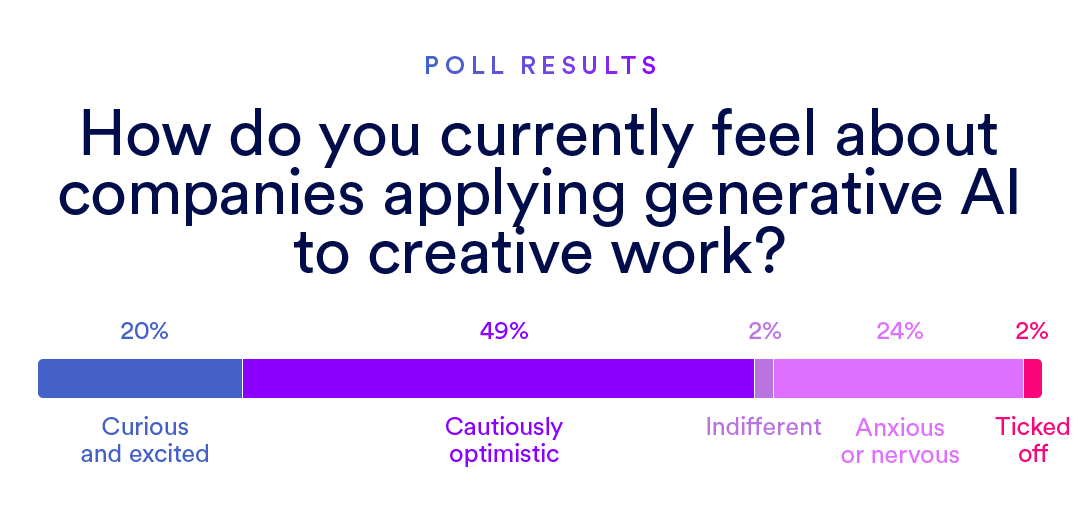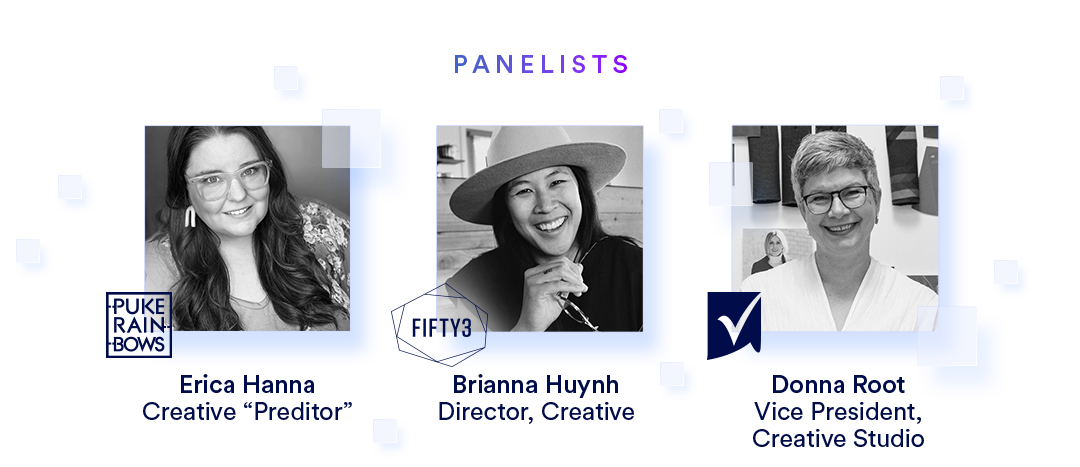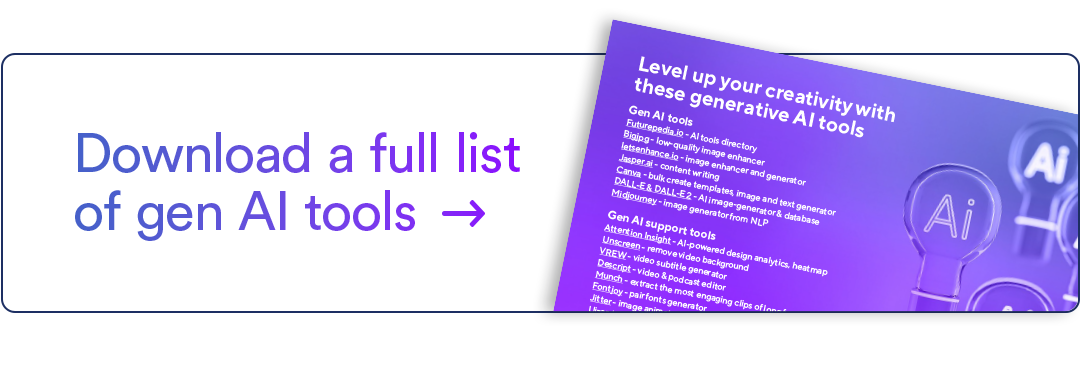AI vs. Creativity: Your Questions Answered
AI isn’t new — but it is entering uncharted territory. While traditional AI recognizes patterns, makes predictions, and automates processes, generative AI tools such as ChatGPT and DALL-E have the ability to create.
From intelligently resizing images to summarizing text, generative AI opens up a world of possibility for creatives by taking on many of the repetitive and administrative tasks that prevent them from focusing on more strategic work. However, along with this exciting promise comes valid concerns.

How will generative AI affect the value of human creativity? What can we do to uphold originality and protect creative property rights? How do we prevent and address the cultural biases that often find their way into algorithms? We recently gathered a group of marketing and creative experts to weigh in on all this intrigue and uncertainty.

The discussion sparked some amazing audience questions, and while we answered many of them live, there were more we wanted to address. So, we followed up with our four fabulous panelists to get their take on the following five questions — let’s dig in!
1. What are your thoughts on utilizing AI for idea generation, but not for final products? Additionally, if you use AI to generate ideas, what do you think are the ethical/transparency guidelines for citing the use of AI?
Erica: Humans have been drawing inspiration for ideas for as long as we've been, well...humans. I love the idea of using AI to generate ideas, but making them your own. However, there is an issue with the fact that some ideas you are generating aren't coming from ‘AI’ as an anonymous tool/robot, because AI has learned about these ideas from human data. So, the most important thing IS to make them your own, put your spin on them, and really customize them to your use case.
Unfortunately, transparency guidelines are so muddy currently. For example, do we list anytime we draw inspiration from Google, a concert we attended, or an art show that lives in the back of our minds years later? Not necessarily. But I think that's where we need to be careful in making our prompts incredibly specific, unique, and valuable. The ‘sweet spot’ where AI is concerned is being able to communicate your idea clearly, which we can all use practice with!
Brianna: At my agency, we use AI mostly to assist with creative conceptualization. Our ideas are unique and the final product that we deliver is also customized to achieve a specific business strategy, but we are able to get to that final deliverable faster because we use AI to iterate on our original idea more quickly.
"I think leveraging AI in this way — in the middle of the creative process versus at the beginning or end — helps solve a lot of the issues folks have around ethics and transparency. Because the initial idea and eventual output are your own, AI essentially becomes a source of inspiration, just like anything else."
— Brianna Huynh, Creative Director, Agency FIFTY3
Having said that, sharing exactly how and why you use AI in the creative process, even if it is only in the middle for conceptualization, is critical to maintaining trust with clients and leadership. And as we move forward and people really start to understand the benefits of AI, I believe that it will become less of a controversial practice, and companies will actively seek out agencies and employees that have experience doing this.
2. What recommendations would you have for making inroads with employers who are taking a very conservative approach to AI (i.e., not readily adopting it) due to concerns about copyright issues, inaccurate information, etc.?
Donna: Those concerns are definitely understandable, especially for industries like healthcare or finance where there’s a lot of sensitive information and privacy requirements.
"Give new AI tools a try in internal, non-customer facing ways first. Consider them for first-draft writing assignments or concept illustrations. If the tools are useful to you, share the results of your experiments and be ready with a proposal on how you could continue to use an AI tool and be within company policies.”
— Donna Root, VP Creative Studio, Smartsheet
Erica: Honestly, as someone who's worked with multi-billion dollar companies with a lot of proprietary information and a lot to lose, I can understand why some companies are approaching AI in a conservative way. In my opinion, the way to make inroads is to demonstrate where there are inefficiencies in your team or process.
This can also be a very vulnerable place for an employee, but demonstrate your resourcefulness by providing an example (not using company data) that can be easily applied to everyday work. Employers want the most efficient use of time because time is money, and if you can prove it will help the bottom line, then you will have a great start in that conversation.
3. Do you think that in the future people will have problems finding jobs in the creative field (e.g. agencies) as companies are replacing people with AI to save costs?
Brianna: I truly believe that creativity is an innately human quality that actually sets us apart from machines. And while machines may help us iterate on or scale our creative ideas more quickly, humans are still the creative brains behind the operation, if you will.
I do think that more companies will want to leverage AI to accelerate the creative process, and that finding jobs will be easier for creatives who know how to take advantage of these tools to augment their workflows and be more productive. I highly recommend every creative get serious about prompt engineering because I foresee the ability to use AI to rapidly explore highly nuanced creative concepts becoming a differentiating creative skill.
Donna: Maybe at companies where people don’t understand the real value of creativity — but who would want to work at a place like that anyway!? Cutting costs is always great, but designers and copywriters are key components of the revenue generating machine — not just cost centers. True creatives don’t go off in a vacuum and spin up a few visually pleasing ad units that the company has to pay for people to click on.
They use visuals and words to tell a story that connects their company’s business strategy, audience needs, and market opportunities in a way that makes people want to engage and ultimately make a purchase. That’s where the true value and purpose of creativity lies, and only humans can do that. So, while the role of the creative person may evolve to focus more on the strategic components of work and find ways to incorporate these new AI tools into the creative process to save time or scale production, I don’t think the creative field as a whole will be overrun by generative AI.
Erica: I don't think that people will necessarily have trouble finding jobs, but I do think that people who don't use AI will potentially be replaced by folks in those jobs who also know how to use it as a resource. It's another tool in your tool belt. Thirty years ago a video editor wouldn't have used Adobe Premiere to create videos, but eventually it became much more efficient than splicing videos together by hand.
Thus, ‘tape-to-tape’ video editors were suddenly not valuable, but the folks who hopped on board with this new technology found job security. Be smart. Use your creative ideas to the best of their potential, but also automate the stuff you don't want to do with AI so that you can spend more time being the creative powerhouse that you are.
4. Have you found any way to help AI ensure that what it creates brings DE&I into the results?
Donna: AI learns based on existing data that we humans generate. So while it’s not a short-term solution, the most effective way for companies to improve the diversity and inclusivity of AI results is to prioritize their DE&I initiatives so that over time the data that AI is taking in and using to generate its own ideas becomes inherently less biased.
There’s this great commercial from SoFi where they explain how they asked AI to show them images of people who are good with money and good at earning money, and only 2% of the images it returned were of women. But in reality, women have statistically less credit card debt than men, women’s investment portfolios outperform men’s on average, et cetera. The commercial ends with SoFi’s promise to empower women financially and actively work to change this outdated and biased perception. And I think that change will happen a lot faster and be more successful if we all take a similar approach.
Brianna: This is a critical issue that will only become more important and pressing as time goes on. I don’t think there’s a quick-fix silver bullet because AI is being trained to ‘think’ like a member of society — and unfortunately many people are still racist and homophobic, for example. So until we as society eliminate these prejudices and biases, there is a risk that AI will perpetuate them as well.
Right now, the best way to ensure DE&I is for humans and AI to work together — which is usually referred to as having a ‘human in the loop.’ If you are using generative AI, make sure you have someone dedicated to consistently reviewing the data that your models are being trained on to eliminate any discriminatory inputs. Of course, there is also a lot of work being done to create algorithms that help detect human biases. So, I think that there is actually a lot of potential for humans and machines to collaborate and work together to improve DE&I in the future.
5. How do you anticipate that AI tools will evolve in the next year or two? (E.g. homegrown solutions, legal rulings, etc.)
Erica: As someone who is the co-founder of a generative AI marketing startup used in video, I'm probably a little bit biased, but I'm going to put my money on video being the next thing. Our developers are already making improvements, tweaks, and adding features to camcorder ai so fast that I need to keep re-recording the intro/demo video for our website!
On a political note, my hope is that there will be some laws put into place as soon as possible regarding the use of AI in political ads. The scale of how misleading information can impact elections and the future is honestly pretty wild!
Donna: Our new campaign tagline "Operate at peak human " is inspired by the impact that each individual can make when they’re able to bring their full selves to work every day. And while some may see this focus on humanity as being in conflict with AI, I actually think it highlights where AI can help humans most.
For so many years we’ve all imagined AI as this all-powerful and almost mythical solution that is going to replace humans and take over the world. But now that it’s actually here and people are able to get their hands on tools like ChatGPT, we’re realizing that while it is extremely powerful, where it really shines and adds value is in its more practical applications. So I think the AI tools we will see come to fruition in the future will be those that really focus on helping knowledge workers make incremental efficiency gains so they can focus on more strategic and creative work — more along the lines of summarizing long form content for short form formats rather than generating an entire content marketing strategy from scratch, for example.
Hear more from our panelists
Did you miss the live webinar? Fear not! Watch it on-demand to hear our panelists answer more questions, including:
- Can AI truly generate new ideas and be considered “creative”?
- What skills and knowledge should creative professionals develop to effectively work with AI technologies?
- How has AI influenced the creative process in your personal experience?

